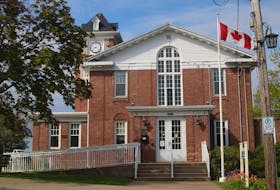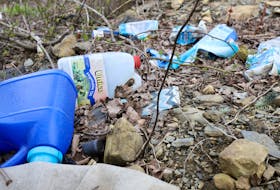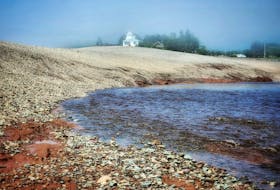It’s the kind of place where neighbours know each other and where on the quiet dirt roads that branch off the main road children rush to look out the window when they hear a car pass.
So it’s not surprising that a tall fence erected last year around 25 acres off land off the main road is attracting some attention. Add to it an increase in traffic in and out of the property and a building going up and local talk is sure to happen.
Mark and Deborah Geck are more than willing to let people in on their secret.
They’re starting a haskap berry operating called Haskap Hill Farm. Right now they have about five acres planted with another seven prepared for planting next year. Eventually they’d like to have the entire 25 acres filled with the fruit-bearing bushes.
Haskaps are an antioxidant-rich berry that is gaining praise for its health benefits.
“The berry is just so good. That’s why we’re growing it because we want it,” Deborah said.
While they are still some way from being able to make commercial sales off the crop, the Gecks are optimistic about the market that exists.
There are several different varieties of haskaps that range from tart to sweet and the uses range from fresh berries to wine and jams.
They’ve been getting a lot of advice along the way from LaHave Natural Farms in Mahone Bay, where they’ve been growing the berries on a commercial scale for a number of years.
“It’s because of their products that we loved it so much.”
LaHave sells its product line to large grocery stores and has had to bring in berries from Russia to meet the demand.
As they set up the farm, the Gecks are trying to take as natural an approach as possible. They’ve left half the property untouched with wildflowers growing naturally to create an environment full of pollinators, which they hope will pollinate the crops.
“We’re trying to bring the natural bees back,” Deborah said. “It’s more about doing stuff for the environment.”
They won’t be using herbicide or pesticide or manure either. Instead they have something on their tractor that helps plow up the weeds and then have workers hoe close to the plants. They’ll be making a compost tea for the bushes which includes ingredients like molasses to help the plants grow. The building currently under construction by Shady Lane will be used to house the equipment to make the compost for the plants.
Deborah said they’re still a few years away from being able to sell, but had a handful of berries this year. By year three or four she estimates they’ll have enough for family and friends and then after that they’ll look at where to go.
“It’s our retirement scheme and something to keep him busy,” she says referring to Mark.”I think he just wanted a tractor.”
Haskap Berry Facts
- Haskap is the Japanese name for Lonicera caerulea, which is also known as blue honeysuckle, honeyberry, edible honeysuckle or sweet berry honeysuckle.
- When translated into English, it’s sometimes spelled as Hascap, Haskaap or Hasukappu.
- Haskap is an ancient Japanese name meaning “berry of long life and good vision.”
- The berries are native to northern Japan, Russia and Canada.
- The cultivated plant was first introduced to Canada in Alberta in the 1950s, but the fruit was bitter and unpalatable.
- It was since introduced by the University of Saskatchewan Fruit Breeding Program, and is being harvested, processed and marketed domestically and in export markets.
- The fruit is an oblong blue-coloured berry about one centimetre in diameter.
- The fruit is often mistakenly thought to be part of the vaccinium family, which includes blueberries and cranberries, however the fruit is more closely related to tomatoes, snowberries and elderberries.
- The flavour has been described as a combination of blueberry, raspberry and black currant.
- Haskap berries are used to make jam, pie filling, desserts, smoothies and juices, and can be added to salads.
- The fruit is high in Vitamin C and A, as well as fibre and potassium.
- The berries also have extremely high levels of antioxidants.
Sources: haskapberries.com and haskap.ca
It’s the kind of place where neighbours know each other and where on the quiet dirt roads that branch off the main road children rush to look out the window when they hear a car pass.
So it’s not surprising that a tall fence erected last year around 25 acres off land off the main road is attracting some attention. Add to it an increase in traffic in and out of the property and a building going up and local talk is sure to happen.
Mark and Deborah Geck are more than willing to let people in on their secret.
They’re starting a haskap berry operating called Haskap Hill Farm. Right now they have about five acres planted with another seven prepared for planting next year. Eventually they’d like to have the entire 25 acres filled with the fruit-bearing bushes.
Haskaps are an antioxidant-rich berry that is gaining praise for its health benefits.
“The berry is just so good. That’s why we’re growing it because we want it,” Deborah said.
While they are still some way from being able to make commercial sales off the crop, the Gecks are optimistic about the market that exists.
There are several different varieties of haskaps that range from tart to sweet and the uses range from fresh berries to wine and jams.
They’ve been getting a lot of advice along the way from LaHave Natural Farms in Mahone Bay, where they’ve been growing the berries on a commercial scale for a number of years.
“It’s because of their products that we loved it so much.”
LaHave sells its product line to large grocery stores and has had to bring in berries from Russia to meet the demand.
As they set up the farm, the Gecks are trying to take as natural an approach as possible. They’ve left half the property untouched with wildflowers growing naturally to create an environment full of pollinators, which they hope will pollinate the crops.
“We’re trying to bring the natural bees back,” Deborah said. “It’s more about doing stuff for the environment.”
They won’t be using herbicide or pesticide or manure either. Instead they have something on their tractor that helps plow up the weeds and then have workers hoe close to the plants. They’ll be making a compost tea for the bushes which includes ingredients like molasses to help the plants grow. The building currently under construction by Shady Lane will be used to house the equipment to make the compost for the plants.
Deborah said they’re still a few years away from being able to sell, but had a handful of berries this year. By year three or four she estimates they’ll have enough for family and friends and then after that they’ll look at where to go.
“It’s our retirement scheme and something to keep him busy,” she says referring to Mark.”I think he just wanted a tractor.”
Haskap Berry Facts
- Haskap is the Japanese name for Lonicera caerulea, which is also known as blue honeysuckle, honeyberry, edible honeysuckle or sweet berry honeysuckle.
- When translated into English, it’s sometimes spelled as Hascap, Haskaap or Hasukappu.
- Haskap is an ancient Japanese name meaning “berry of long life and good vision.”
- The berries are native to northern Japan, Russia and Canada.
- The cultivated plant was first introduced to Canada in Alberta in the 1950s, but the fruit was bitter and unpalatable.
- It was since introduced by the University of Saskatchewan Fruit Breeding Program, and is being harvested, processed and marketed domestically and in export markets.
- The fruit is an oblong blue-coloured berry about one centimetre in diameter.
- The fruit is often mistakenly thought to be part of the vaccinium family, which includes blueberries and cranberries, however the fruit is more closely related to tomatoes, snowberries and elderberries.
- The flavour has been described as a combination of blueberry, raspberry and black currant.
- Haskap berries are used to make jam, pie filling, desserts, smoothies and juices, and can be added to salads.
- The fruit is high in Vitamin C and A, as well as fibre and potassium.
- The berries also have extremely high levels of antioxidants.
Sources: haskapberries.com and haskap.ca








